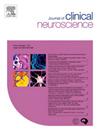高位椎动脉横孔引导下C2椎弓根螺钉置入的影像学分析
IF 1.8
4区 医学
Q3 CLINICAL NEUROLOGY
引用次数: 0
摘要
背景:C2椎弓根螺钉(C2 PS)具有良好的固定效果,但存在椎动脉损伤风险,高椎动脉(HRVA)和狭窄的C2椎弓根会加剧椎动脉损伤,因此需要其他安全方法。本研究评估了一种替代技术的安全性和可行性。方法回顾性分析2020年4月至2022年12月在台中退伍军人总医院进行的治疗寰枢椎不稳的C2 PS置入。替代技术涉及高速毛刺,以确定C2 PS的进入点。术中透视证实了触诊引导下的螺钉置入。术前和术后计算机断层扫描用于评估椎弓根尺寸、螺钉角度和断裂。建立HRVA和窄蒂分类。术后扫描使用分级系统来识别违规行为。影像学资料独立评估。结果39例患者中有18例出现HRVA。HRVA组和非HRVA组在椎弓根尺寸和螺钉角度上有显著差异。总体违约率为15.4%,HRVA案件的违约率高于非HRVA案件(27.8%)。外侧-下切口为主,所有切口均位于右侧。无症状性并发症。结论这种替代技术安全可行,特别是对HRVA患者。对于椎弓根狭窄的hrva,可以考虑使用较短的椎弓根螺钉。C2 PS放置的另一种技术似乎有利于降低违约率,特别是在具有挑战性的情况下。本文章由计算机程序翻译,如有差异,请以英文原文为准。
Radiographic analysis of C2 pedicle screw placement guided by the transverse foramen in patients with a high-riding vertebral artery
Background
C2 pedicle screws (C2 PS) offer superior fixation but pose vertebral artery injury risks, accentuated by a high-riding vertebral artery (HRVA) and narrow C2 pedicle, prompting alternative approaches for safety. This study evaluated the safety and feasibility of an alternative technique.
Methods
This retrospective analysis focused on C2 PS placement for atlantoaxial instability and was conducted at Taichung Veterans General Hospital from April 2020 to December 2022. The alternative technique involved a high-speed burr that determined the C2 PS entry point. Tactile palpation-guided screw placement was confirmed using intraoperative fluoroscopy. Preoperative and postoperative computed tomography scans were used to assess pedicle dimensions, screw angles, and breaches. A HRVA and narrow pedicle classification were established. Postoperative scans were used to identify breaches by using a grading system. Radiographic data were assessed independently.
Results
A HRVA was present in 18 out of 39 patients in whom C2 PS placement was performed. Significant differences in the pedicle dimensions and screw angles were observed between the HRVA and non-HRVA groups. The overall breach rate was 15.4 %, with higher rates in the HRVA cases than in the non-HRVA cases (27.8 %). Lateral-inferior breaches were predominant, and all breaches were on the right side. No symptomatic complications were noted.
Conclusions
This alternative technique appears safe and feasible, especially in patients with a HRVA. Shorter pedicle screws may be considered for HRVAs with narrow pedicles. An alternative technique for C2 PS placement appears to be beneficial for reducing breach rates, especially in challenging cases.
求助全文
通过发布文献求助,成功后即可免费获取论文全文。
去求助
来源期刊

Journal of Clinical Neuroscience
医学-临床神经学
CiteScore
4.50
自引率
0.00%
发文量
402
审稿时长
40 days
期刊介绍:
This International journal, Journal of Clinical Neuroscience, publishes articles on clinical neurosurgery and neurology and the related neurosciences such as neuro-pathology, neuro-radiology, neuro-ophthalmology and neuro-physiology.
The journal has a broad International perspective, and emphasises the advances occurring in Asia, the Pacific Rim region, Europe and North America. The Journal acts as a focus for publication of major clinical and laboratory research, as well as publishing solicited manuscripts on specific subjects from experts, case reports and other information of interest to clinicians working in the clinical neurosciences.
 求助内容:
求助内容: 应助结果提醒方式:
应助结果提醒方式:


